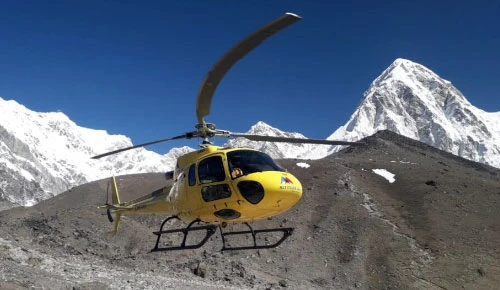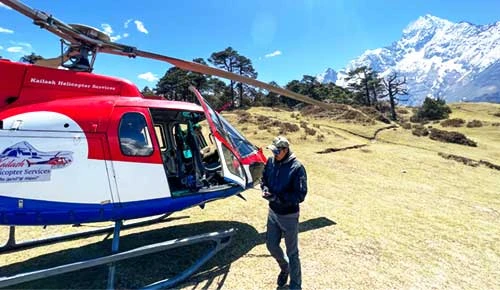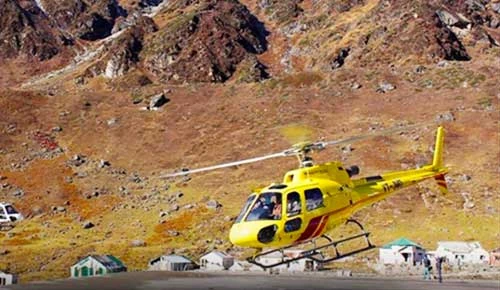Kanchenjunga Conservation Area
The Kanchenjunga Conservation Area is a vast wilderness in one corner of the Himalayan region. An area of 2035 square kilometers was established to preserve one of the ecologically diverse and culturally richest areas in the Himalayas.
The conservation area, which takes its name from Mt. Kanchenjunga, the third highest peak in the world,. It is an undiscovered land in the Kanchenjunga region that meets the need for unspoiled tranquility, adventure parks, and genuine encounters with other cultures at its best.

The KCA provides a unique combination of nature and heritage by way of snowcapped summits, beautiful valleys, and endemic wildlife species. The site does not only serve trekkers or nature lovers but it also plays an important role in Nepal’s drive towards conserving biological diversity and promoting sustainable tourism.
Key Details of Kanchenjunga Conservation Area
Key Details | Information |
Location | Northeastern Nepal, Taplejung District, sharing borders with India (Sikkim) and China (Tibet). |
Established | In 1997, as part of the Sacred Himalayan Landscape Initiative. |
Total Area | 2,035 sq km, making it one of Nepal’s largest protected areas. |
Altitude Range | 1,200 m to 8,586 m, including tropical forests to high alpine landscapes. |
Highest Peak | Mount Kanchenjunga (8,586 m), the third highest mountain in the world. |
Climate Zones | Subtropical at lower levels to alpine at higher altitudes, with monsoon rains from June to September. |
Rivers and Glaciers |
|
Accommodation Options | Tea houses and basic lodges along trekking routes, with camping required for remote areas. |
Entry Permits | Kanchenjunga Restricted Area Permit and TIMS card required. |
Best Time to Visit | Spring (March-May) and Autumn (September-November) for the best weather and clear mountain views. |
Access Point | Taplejung, accessible via flight to Suketar or by road from other parts of Nepal. |
Support for Selves | The local economy relies on farming, livestock keeping, and tourism, with growing eco-tourism initiatives. |
Protection Program | WWF Nepal collaborates with local communities for wildlife conservation and community-driven conservation efforts. |
UNESCO Tentative List | The Kanchenjunga Conservation Area is on the tentative list for recognition as a UNESCO World Heritage Site. |
Table of Contents
History and Establishment
The Kanchenjunga Conservation Area was established in 1997, mainly with a view to safeguarding its rare biodiversity and cultural legacy. The conservation area was established as a response to the mounting threats posed by habitat loss and poaching in the region.
It's about 2,035 square kilometers in area and includes the sides of the Kanchenjunga mountain range and valleys next to them. The goal of this project was to keep the balance between people and wild animals so that future generations could enjoy its beauty and biological importance.

Since it started, this KCA has done a lot to help protect these huge differences in its area. It was very important for the World Wildlife Fund (WWF) to work with people on long-term solutions that help protect wildlife. Local partners, such as traditional residents, have been involved in management tasks and safety measures.
These partnerships have not only helped protect animals and plants, but they have also given people in the area the confidence to take care of their own surroundings.
Geography and Landscape
The Kanchenjunga Conservation Area (KCA) occupies a region close to India and Tibet, spanning approximately 2, 000 square kilometers in the northeastern part of Nepal. The beautiful landscape ranges from lower subtropical forests to the highest alpine peaks, including Mount Kanchenjunga, the world's third highest mountain.
The area has different types of landscape; it has deep valleys, glacial rivers, lush forests, and so on. As one moves along this region, one would witness bamboo and rhododendron jungles in lowlands or would have to scale heights of alpine meadows and glaciers.
This kind of geographical diversity creates wonderful visual contrasts, characterized by fertile green valleys below and icy mountain ranges above. Across these various ecological zones, KCA supports rich biodiversity, each with its own plant and animal characteristics. The glaciers in the area feed major rivers like Yalung Glacier.
Therefore, KCA covers very high variations in terms of harsh alpine environments alongside ubiquitous low-lying lands, making it an important site for conservation purposes as well as a must-see destination for trekkers, who must admire while observing nature’s beauty.
Flora and Fauna
A heaven for biodiversity, the incredible variety of plants and animals in the Kanchenjunga Conservation Area is unmatched. home to some endangered creatures like snow leopards and red pandas, this region has other diversity features such as forests inhabited by many kinds of deer, bears, and wild pigs.
Moreover, different types of birds, including the Himalayan monal, which is an avian symbol for Nepal, are found here. For their continued existence, these organisms depend on various forms of habitats found within the KCA.

Equally astounding is KCA’s vegetation, comprising thick forests made entirely out of rhododendrons, pure bamboo thickets, or even some highland meadows without sedimentary rocks. This area is famous for its abundant medicinal plants as well as orchids that flourish in it.
Several species found here occur nowhere else, adding to the ecological importance of the conservation area. In addition to safeguarding traditions and customs related to them, it’s critical that we protect these kinds from extinction so that we can maintain nature’s equilibrium.
Indigenous Communities and Culture
The Kanchenjunga Conservation Area is home to a number of different indigenous groups, each with its own unique culture and set of traditions. There are people from the Rai, Limbu, Sherpa, and Tibetan groups living there. The place is a culture mosaic.
For centuries, these ethnic groups have lived shoulder to shoulder with nature, thereby forming a strong attachment to land. Their handover of ancient knowledge along with practices has greatly been instrumental in both conserving this area and sustainably utilizing its resources.

Tibetan Buddhism is very much reflected in the local culture, where many monasteries and prayer flags are located within the entire conservation area. Festivals, rituals, and everyday life often reflect spiritual beliefs intermixed with earthly concerns so that their coexistence resembles an ecological balance between humans and the environment.
Visitors will appreciate this cultural diversity because it serves as a source of information about ways of life among indigenous people; besides this, it portrays preservation efforts for natural resources as well as cultural heritage.
Popular Trekking Routes
The area for conservation of Kanchenjunga is well-known all over the world for trekking; that is why there are various popular trails with striking viewpoints incorporated into them. One of these trails is known as the Kanchenjunga Circuit Trek, which takes trekkers around massive Kanchenjunga itself.
This specific hike offers some breathtaking views of the most elevated mountaintop in the world; it also displays other giant items in such a rocky place. It moves through various types of landscapes ranging from deep jungles to high altitude passes, covering a comprehensive experience about beauty in nature throughout this region.

Some more significant trekking routes within KCA include the Kanchenjunga Base Camp Trek and the Ghunsa-Kambachen Trek. Giving other angles for viewing this area, Base Camp Trek provides an up-close picture from the south face of Kanchenjunga, whereas Ghunsa to Kambachen Trek reveals remote corners as well as little visited parts of the area. Each trekking adventure has its individual challenges and highlights, thus catering for different levels of trekking skills and interests.
Conservation Efforts and Challenges
The conservation efforts for Kanchenjunga Conservation Area were multifaceted and vigorous and aimed at protecting the different species of living creatures as well as ecosystems that are found within the region.
One of the key elements of conservation activities has been the establishment of community-based programs in which locals take part in sustainable tourism practices, among other things. At the same time, these methods have helped protect the environment and provide income for locals, creating a sense of ownership over nature.
Climate change transforms the way the weather works and hurts sensitive ecosystems in these places. KCA still has to deal with a lot of problems. People are also still worried about the loss of environment that comes from things like farming and cutting down trees
Also, conflicts between people and animals, especially those involving endangered species, are still a problem. To protect the Kanchenjunga Conservation Area in the long run, conservation groups, local communities, and government agencies must continue to work together to solve these problems.
How to Visit the Kanchenjunga Conservation Area
Best Time to Visit
- Spring: March to May—Free from clouds and moderate temperatures.
- Autumn: September to November: excellent trekking conditions and magnificent views.
Permit Requirements:
- Acquire the necessary permissions via the Nepal Tourism Board or recognized trekking agencies.
- Confirm that all requisite permits have been acquired prior to starting off on the trail.
Trekking Preparations:
- Gear: Pack suitable clothing depending on the weather, including layers to keep warm when it is cold.
- Equipment: Bring trekking gear like durable boots for hiking as well as sleeping bags.
- Supplies: Carry enough food, water, and snacks throughout the journey. Also consider carrying portable means of purifying water.
Physical Preparation:
- Physical fitness is important because of the demanding nature of these treks.
- Regular exercise and training are important for high-altitude trekking.
Security Measures:
- Guides and porters: Hire experienced guides as well as porters to help with navigation and provide assistance.
- Altitude sickness: recognize the symptoms and take appropriate precaution, such as having acclimatization days.
Travel and Logistics:
- Plan your trip to the starting point of the trek, which can be accessed either by road or a combination of both road and domestic flights.
- Book accommodation facilities and transport ahead of time, especially during peak trekking seasons.
Responsible Tourism:
- Follow Leave No Trace principles to minimize environmental impact.
- Respect local customs and traditions, and support local communities through eco-friendly practices.
Conclusion
The tranquil location of Kanchenjunga is a marvel in itself, with incredible views and rich animal varieties. Wildlife enthusiasts can view creatures such as red pandas and snow leopards, wander through forests made entirely of rhododendron trees or participate in ancient cultural practices.
Choosing to know it firsthand supports important conservation programs, hence securing the preservation of this place for posterity. We encourage you to undergo a journey into this valuable secret where your thrill-seeking journey goes towards maintaining its landscape and cultural legacy.
Make sure you make a booking right now!








